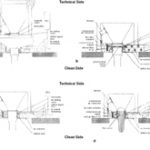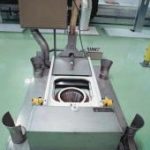The hidock. docking station concept is designed to comply fully with GMP guidelines. The system ensures absolutely tight separation between the technical and clean room areas at any time. hidock. docking stations allow the prod-uct transfer between clean production rooms and less clean technical areas to be executed under tight and perfect GMP conditions.
Gernot Ingenerf
In the pharmaceutical industry, products such as powder mixtures, granules, pellets and other solid matter are generally stored inside clean production rooms. Since the requirements specified for clean rooms are very strict and can only be satisfied at a high cost, it is obvious that using clean production facilities for storage purposes is a luxury. Heinen recently presented the hidock. docking station concept developed and patented by Professor Lhoest and Elveco, Belgium. This system is designed for storing solid matter in a simple technical area, thereby significantly reducing the necessary clean room facilities and enabling the product to be transferred between the technical area and the clean room under perfect GMP conditions. It allows the manufacturer to store product bins inside the technical area and outside the clean room.
The traditional weaknesses of ordinary container stations, such as tightness, dust emissions, maintenance problems, leakages to the clean rooms and validation difficulties, are eliminated by this concept.
The invention of this system marked the birth of a new generation of pharmaceutical plants which also includes other very successful concepts, such as full gravity flow, multi-level design, absolute containment, automated product handling and computer aided manufacturing.
The station allows the product to be transferred under closed conditions between a bin (industrial container = IBC), installed in the technical area either above or below the clean room, and the production plant inside the clean area. The bin is transported and delivered to the station by a manual forklift or an automated guided vehicle. The gravity flow of material facilitates optimum conditions, even for dusty products.
The system ensures absolutely tight separation at any time during docking, loading, discharging, undocking and during inspection, cleaning and maintenance. The hermetically sealed access, both from the clean room area and from the technical area, avoids contamination during docking and inspection.
The principle of the docking station can be illustrated by describing it as an airlock (air box) equipped with two doors. No CIP liquids are needed, because the system operates with a self-cleaning air box with access from the clean room side. Additional sealing is provided by two inflatable seals on the station, two butterfly valves and two sliding covers for double safety.
The extremely flat design reduces the required overall height and enables quick connection to existing production plants.
Principle of the docking process
The docking process consists of four steps:
- The bin is lowered vertically on the technical side. The bin columns are docked by means of four positioning shoes mounted directly on the frame. These guide shoes are able to correct positioning errors of ±3 cm in both horizontal directions. After docking, the pneumatic seals are deaerated and the upper door slides open. The drop sliding cover remains closed.
- As soon as the bin has been docked and the upper slide opened, the pneumatic seals are inflated and the air chamber is flushed by jets of medical-grade compressed air. It remains under slight negative pressure after flushing and there is a gentle flow of HEPA H12 filtered air.
- The lower slide door can then be released. To connect the bin valve actuator and make the connection with the bin valve, an inflatable gasket forces the powder drop downwards, compressing the gasket onto the flange of the valve. This completes the docking operation.
- The bin is connected to the station. When released by the operator, the valve opens and the product is transferred to the production machine. The bin valve actuator ensures a progressive rotary movement with the help of positioners, allowing the valve to remain open at any pre-programmed angle.
cpp 442
Share:








